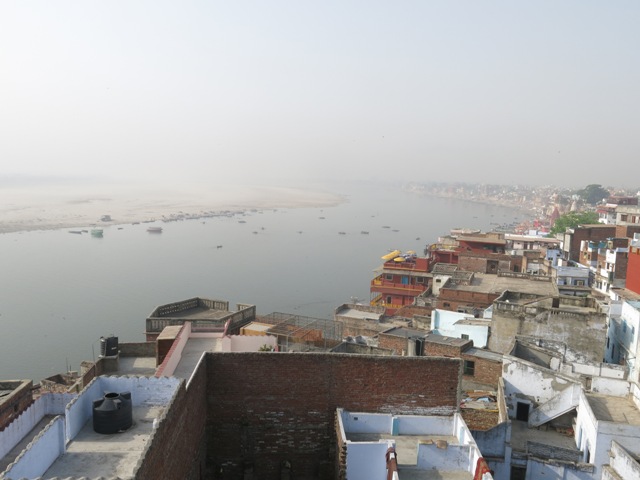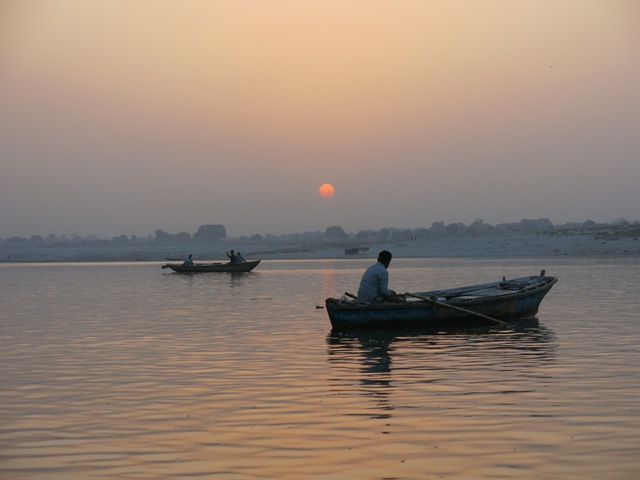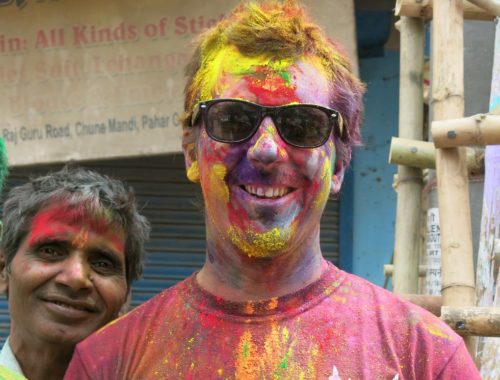It’s 5:30am and barely a glimmer of natural light illuminate the scene as I follow a trio of German tourists down the staircase of my digs. Bodies are draped over most of the spare surfaces in the lobby. They’re the workers of Puja Guesthouse in Varanasi and our lobby is their home.
The workers stir, one quickly taking charge and summoning our captains for the day. Then we’re on our way, blinking, into the morning light, following the leader and a pair of boys who can’t be older than 15 apiece through narrow alleys and long tunnels, down the crumbling stone steps that lead to the Ganges River. Or as residents call it, often in hushed tones, Ganga. Lifeblood of Varanasi.
It’s surprisingly bright outside as our leader effortlessly leaps across the faded glory of the wooden boats roped near shore. He unties a large one for the three Germans, which one of his sidekicks climbs into and rows away. A French couple arrives at the docking point; they jump the queue, with the youngest boy as their skipper.
The group leader unties a smaller boat, more befitting my group of one, and motions me to climb aboard. He was playing street cricket yesterday, bowling with the pace and guile of Lasith Malinga down an alley barely the length and width of a standard pitch. I strode to the crease and confidently took guard against a boy barely half my age, confident that all of those years of backyard cricket would trigger muscle memory in my body.
My reflexes, however, weren’t quite up to the pace – I played and missed twice before gloving a difficult chance to short mid-on from his third delivery. It was time to retire hurt with my pride still relatively intact.
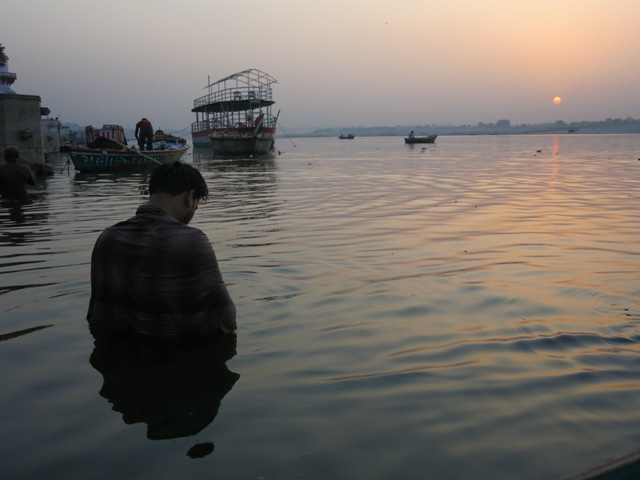
Today, the street slinger is playing foreman. Taking a seat at one end of the boat, he grasps oars fashioned from bamboo poles and wooden planks and skillfully weaves around a man torso-deep in the Ganga, wide eyeballs deep in a trance, oblivious to everything but whatever is in the focus of his mind’s eye. We put space between our vessel and the shore as we slowly begin to make our way south-west.
“Sun. Look.” He motions over my left shoulder, to the first signs of the orange disc showing its face over the sand and tree-lined embankment flanking the Rajghat Bridge. It appears in silhouette, then as a half shape, then it’s just there, somehow skipping that impossible to define moment between rising and risen.
The walkway and steps flanking this western side of the Ganges are already busy, not only with bathers and worshippers but with groups of youths just milling about. The fast bowler/foreman spots someone he knows, calls to him, then powerfully guides us to shore, his wiry frame and the faintest hint of a moustache putting him a little older than his peers.
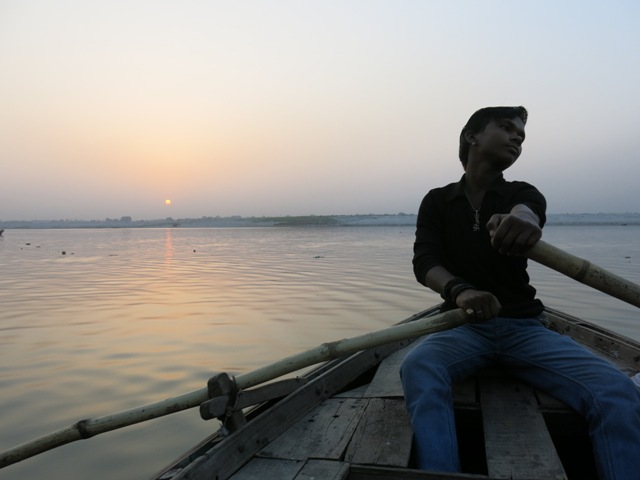 “My brother,” he says as he climbs onto the cement, handing the oars to another of yesterday’s street cricketers. He’s younger, hipper, decked out in black skin-tight top accessorised with silver necklace bearing the Hindu/Nazi cross, denim jeans and Adidas sneakers. He slips in the white headphones attached to his mobile phone, narrowly avoids another man lost in the sunrise behind us, and we continue our south-west.
“My brother,” he says as he climbs onto the cement, handing the oars to another of yesterday’s street cricketers. He’s younger, hipper, decked out in black skin-tight top accessorised with silver necklace bearing the Hindu/Nazi cross, denim jeans and Adidas sneakers. He slips in the white headphones attached to his mobile phone, narrowly avoids another man lost in the sunrise behind us, and we continue our south-west.
The bells are ringing in the Dashmawedh Ghat, the morning equivalent of the previous evening’s Brahman cleansing ceremony still a few hours away. As many people are sitting in silence near the river’s edge as there are washing themselves in its murky, seemingly impenetrable depths. The Ganga’s power is undeniable, even if you’re not among the many foreigners here in search of eastern spiritual enlightenment.
Sit in on the evening Ganga Seva Nidhi Ceremony and you may well find your answers. Boats loaded with tourists congregate around Dashmawedh, the river’s central hub of worship. Food dye blessings are applied to foreheads, both local and foreign, by men in robes who act first, ask for donations later. A short walk away, four residents are engaged in a ferocious game of riverside badminton, the religious festivities the last thing on their mind.
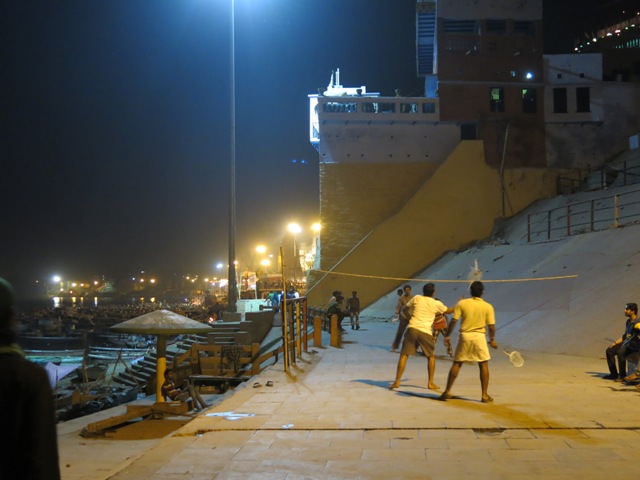 The Brahman ceremony isn’t for everyone. Take the time to find your own vantage point for a spot of quiet reflection on the banks of the Ganga, however, and you may well find what you’re looking for within yourself. Cows bathe in the water, looking as happy as the Luck Dragon from The Neverending Story. Their owners splash water on them, like it’s playtime for them both. Street cricket games are happening everywhere.
The Brahman ceremony isn’t for everyone. Take the time to find your own vantage point for a spot of quiet reflection on the banks of the Ganga, however, and you may well find what you’re looking for within yourself. Cows bathe in the water, looking as happy as the Luck Dragon from The Neverending Story. Their owners splash water on them, like it’s playtime for them both. Street cricket games are happening everywhere.
 My rower’s mother pulls up beside us, hands me two paper trays filled with flowers and a flame, and motions to let them loose in the waters. I do, and she awaits her reward. After I pass her 100 rupees (A$2) my rower pushes off from my boat, offering “Good karma” and nodding sagely by way of explanation.
My rower’s mother pulls up beside us, hands me two paper trays filled with flowers and a flame, and motions to let them loose in the waters. I do, and she awaits her reward. After I pass her 100 rupees (A$2) my rower pushes off from my boat, offering “Good karma” and nodding sagely by way of explanation.
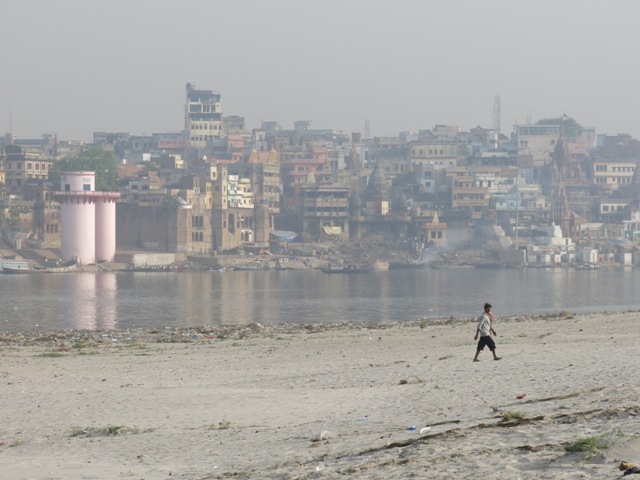 It’s not the first top-up my karmic balance has received here. Yesterday, on my way to Manikarnika – the burning ghat, where cremation ceremonies are a 24/7 operation – I was joined by a man on his way to a silk factory across the river. On arrival I staked out a vantage point at a respectful distance from the cremation site, sipping a Mountain Dew on a bench at a nearby stall.
It’s not the first top-up my karmic balance has received here. Yesterday, on my way to Manikarnika – the burning ghat, where cremation ceremonies are a 24/7 operation – I was joined by a man on his way to a silk factory across the river. On arrival I staked out a vantage point at a respectful distance from the cremation site, sipping a Mountain Dew on a bench at a nearby stall.
For the uninitiated, it was hard to determine where one ceremony had begun and another had ended, or if indeed any cremations were happening before my eyes. Bodies, wrapped in bright robes, were certainly being carried out by family members. Two men worked large fire hoses, hosing debris away from the still smouldering fires. Young men in loin cloths carried large sifting trays, sifting the remnants of past cremations to try and recover jewellery that may have survived the process.
Meanwhile, children were bomb diving into the river from a nearby platform, while a lone young girl strolled through the wreckage picking up plastic bottles for recycling. Life goes on.
My new friend joined me, no longer in a hurry to make it to work, and soon after another new friend joined us. He worked in “management” at the cremation site, proceeding to detail the entire (admittedly fascinating) process to me before I’ve got a chance to halt him. The first member of the tag team offered a quick “goodbye” before heading back in the direction he came from. Half an hour later I’m in a hospice directly above the ceremonies, being blessed by a priest who insists that only with X amount of donation will I receive Y amount of karmic return.
Essentially, the more the merrier.
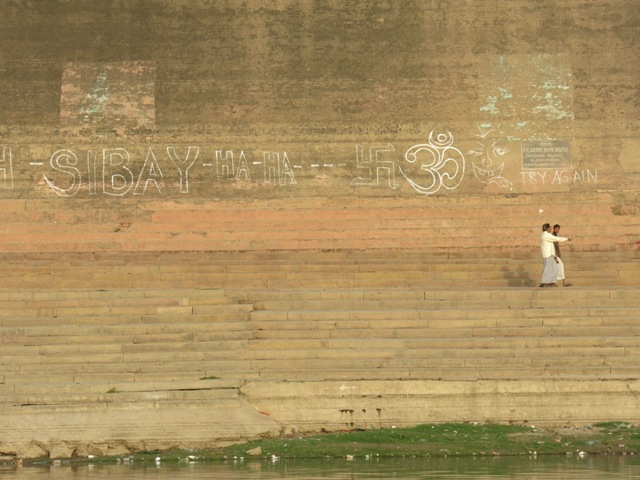 Back on the Ganga, my young guide tears the top off a mint packet, discarding the remains in the river. A thick film floats across much of this northern bank, clinging to the edge of boats still docked at shore. Assorted refuse drifts by. A styrofoam block. A lightbulb. A hog-tied goat carcass. My guide and I lock eyes as we pass the latter. He nods, cracks a wry smile and we continue on, the moment remaining unspoken.
Back on the Ganga, my young guide tears the top off a mint packet, discarding the remains in the river. A thick film floats across much of this northern bank, clinging to the edge of boats still docked at shore. Assorted refuse drifts by. A styrofoam block. A lightbulb. A hog-tied goat carcass. My guide and I lock eyes as we pass the latter. He nods, cracks a wry smile and we continue on, the moment remaining unspoken.
Observing the bathers, particularly the ones with eyes rolled back in solemn thought, feels like an intrusion. For others the occasion isn’t so solemn. Children swim like it’s a day at the beach. A hotel’s laundry team fastidiously soaks, scrubs and rinses the linen, the muscular lead washer methodically beating each sheet on an angled cement plank in a whirling, rhythmic motion.
Women hold up sheets to protect the modesty of other ladies dressing themselves for the morning ritual, then bathe in clusters dotted throughout the predominately male congregation.
Shaven-headed boys in pink robes stand in shabby formation, seemingly paying no heed to the instructions of a chant played over a loud speaker. “Brahman yoga,” says my guide, sensing my quizzical gaze.
We ease up behind the boat holding the French couple, and the drivers exchange barbs. Suddenly a race is on, my charge not able to gain ground on an opponent much smaller but quite obviously faster despite his additional passenger. My rower splashes the French girl, who looks aghast but keeps her lips sealed. Bashful, my rower pulls away and hides his head in mock shame.
The population along the shore line thins out the further we travel. “You try?” asks my rower, motioning for the oars after turning the boat around in the direction of our origin.
“No, no, no.” I shake my head, pointing instead for the eastern sand bank of the Ganga.
“We go there?”
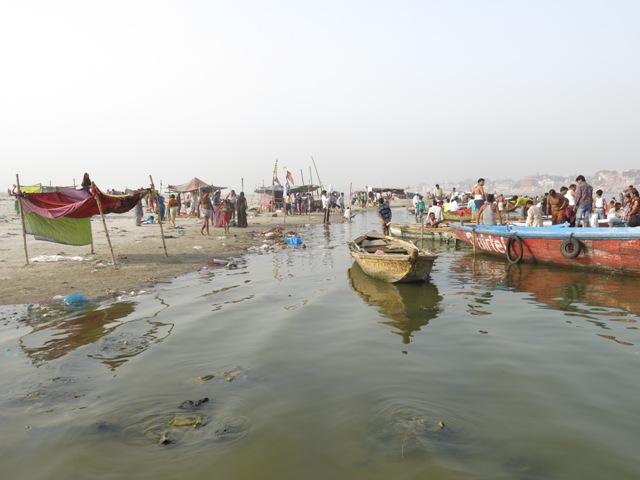 He looks at his clock, and acquiesces. What look to be kites dart back and forth above us, caught in a zephyr that makes them appear attached to unseen strings. A souvenir pottery boat docks next to a larger canoe of Japanese tourists. Fish sporadically break the surface.
He looks at his clock, and acquiesces. What look to be kites dart back and forth above us, caught in a zephyr that makes them appear attached to unseen strings. A souvenir pottery boat docks next to a larger canoe of Japanese tourists. Fish sporadically break the surface.
When I ask why people travel from the west bank to the east, my rower holds his nose together with his thumb and forefinger and motions dipping beneath the water’s surface. It is noticeably cleaner over here, the surface level scum nowhere to be seen. We pull up on the bank and I climb to shore. Though one group chants in the water with eyes closed, it feels more communal here, like anyone can participate.
 An elderly man sits next to a one-man tent that could’ve been shipped straight from a western camping supplier. Behind him rests the rotting frame of a large boat, a husk long since abandoned. Suitcases, fuel tins, coiled up rope and fishing line are scattered across the shore’s expanse.
An elderly man sits next to a one-man tent that could’ve been shipped straight from a western camping supplier. Behind him rests the rotting frame of a large boat, a husk long since abandoned. Suitcases, fuel tins, coiled up rope and fishing line are scattered across the shore’s expanse.
As I walk up the enormous sand bank, I wonder what happened to the rest of the river; about the people whose abandoned campsites lay tattered around me; about what fate awaits my sensitive westerner’s feet after setting foot in the Ganga.
